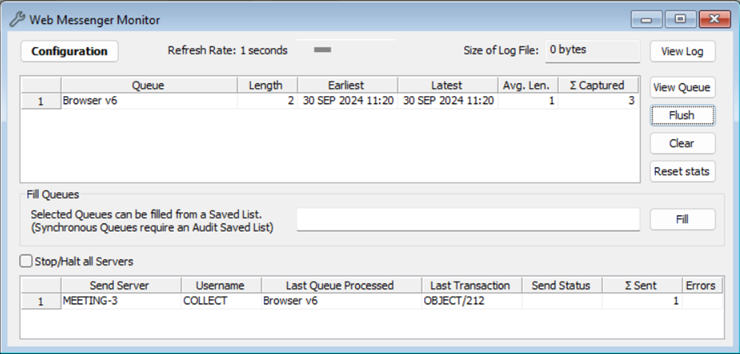Monitor your Web Messenger queues and send servers
You can check what’s happening with your queues and send servers with the Web Messenger Monitor window.
Open Web Messenger Monitor
Go to the Tools menu, then Public Access, then click Web Messenger.

Refresh rate
-
The Refresh Rate sections shows how often the monitor is updating the information on the queue(s).
-
The default is 1 second.
-
You can increase or decrease the refresh rate with the scroll bar.
Size of the log file
-
The Size of Log File section shows the size of the log file in kilobytes.
-
The size depends on the type of log you have selected in the configuration record and the volume of messages since the log was last cleared.
View the log file
You can open the log by clicking View Log. The log will then appear in Notepad.
Clear the log file
You should clear the log periodically.
-
Go to the Wincoll folder, then the DATAVOL folder, and delete the wm_log.txt file.
-
Or click View Log, press Ctrl+A to select all the contents, and then press the Delete key.
Queue table
-
The Queue column shows the listener name. Each listener appears on a separate line. If you have more than one listener (for example, two instances of Vernon Browser), then you will have multiple queues.
-
The Length column refers to the number of pending messages (captured but not sent). Ideally, this should be zero if everything is processing properly. The length will also read zero if you have turned off the capturing function.
-
The Earliest and Latest columns only apply to synchronous queues. They do not apply to Vernon Browser, which uses the asynchronous mode.
-
The Average Length column displays the average length of the queue whenever a transaction is captured. Ideally, the average length should be zero or 1. If the average length is not zero, this may mean that there have been several bulk transactions or that the queue is lagging in processing the messages. However, if the Queue Length has ever been above zero, then the Average Length will never again equal zero. The Queue Length is a better indicator of issues.
-
The ∑ Captured column shows the total number of messages that Web Messenger has captured for this queue. This is a running total. It is not affected by turning the capturing function on or off.
Flush the queue
Click Flush to process all messages in the queue. For more information, see Push updates through manually in Web Messenger.
Clear the queue
Click Clear to clear the queues. You may want to clear the queues if you decide to update Vernon Browser using an export via the Reporting tool instead of Web Messenger.
Reset the statistics
Click Reset stats to reset the Average Length and Σ Captured columns for the selected queues.
Fill Queues
If you stop capturing changes in your records by turning off capturing, then your listener may become out of sync with Vernon CMS. You can manually fill the queue with a saved list and then flush the queue to push the changes through Web Messenger.
For more information, see Push updates manually through Web Messenger.
Stop/halt all servers
Tick the Stop/Halt All Servers checkbox to stop all send servers from sending messages to the listener. You will only use this in an emergency.
Send server table
This table shows which send servers are processing queues. Each active send server will be shown on a separate line in the table. Users that are set up as send servers, but are not currently logged into Vernon CMS, will not show in the table.
